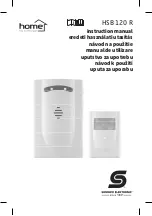
- 7 -
¿WWLQJV
:$51,1* $OZD\V FORVH WKH JDV ERWWOH YDOYH ZKHQ WKH ZRUN KDV EHHQ
FRPSOHWHG
00$ZHOGLQJ
Almost all coated electrodes must be connected to the generator’s positive pole (+),
except acid coated electrodes, which must to be connected to the negative pole (-).
&RQQHFWLQJWKHZHOGLQJFDEOHHOHFWURGHKROGHUFODPS
Fit a special clamp to the terminal which tightens the bare section of the electrode.
This cable must be connected to the terminal with the (+) symbol.
&RQQHFWLQJWKHUHWXUQFDEOHWRWKHZHOGLQJFXUUHQW
To be connected to the piece being welded or to the metal workbench on which it is
SRVLWLRQHGDVFORVHDVSRVVLEOHWRWKHMRLQWWKDWLVEHLQJPDGH
This cable must be connected to the terminal with the (-) symbol.
:(/',1*352&('85('(6&5,37,21
7,*:(/',1*
*HQHUDOSULQFLSOHV
TIG welding is a welding procedure that exploits the heat generated by the electric
arc which is struck and maintained between a non-consumable electrode (Tungsten)
and the piece to be welded. The Tungsten electrode is supported by a torch which is
able to deliver welding current and protect the electrode and the weld pool against
DWPRVSKHULFR[LGDWLRQXVLQJDQLQHUWJDVÀRZQRUPDOO\$UJRQ$UVXSSOLHGYLD
a ceramic nozzle
),**
.
TIG welding is suitable for all low-alloy and high-alloy carbon steels and to heavy
metals, copper, nickel, titanium and relative alloys.
Electrodes with 2% cerium content (grey coloured strip) are generally used for TIG DC
welding with a (-) pole electrode.
It is essential to sharpen the Tungsten electrode axially on a grinding wheel, see
),*
H
, making sure that the tip is perfectly concentric to prevent arc deviation. It is important
to ensure grinding is performed lengthwise along the electrode. This operation must
be repeated periodically according to the use, wear and tear of the electrode, or when
the same has been accidentally contaminated, oxidised or used incorrectly.
To achieve good welding results, it is essential to use the exact electrode diameter and
current, as indicated in the table
7$%
.
The ceramic nozzle will normally protrude from the electrode by 2-3mm, and may
reach 8 mm for corner welding operations.
)XVLRQZHOGLQJVROGHUVWKHMRLQWHGJHV1RZHOGLQJPDWHULDOLVUHTXLUHGZKHQXVLQJ
VSHFL¿FDOO\SUHSDUHGWKLQGLDPHWHUVXSWRDSSUR[PP
),*,
.
When dealing with thicker materials, it is necessary to use suitably sized sticks made
of the same base material, and ensure the edges are prepared properly
),*/
. To
achieve good welding results, it is important to ensure all pieces are perfectly clean,
with no sign of oxide, oil, grease, solvents etc.
3URFHGXUH/,)7VWULNH
8VHWKHNQREWRDGMXVWWKHZHOGLQJFXUUHQWWRWKHUHTXLUHGUDWHDGMXVWWKLVYDOXH
during welding processes to adapt to the actual heat transfer required.
&KHFNWKDWWKHJDVÀRZLVFRUUHFW
The electric arc strike involves the to-and-fro stroke of the Tungsten electrode on the
piece to be welded. This strike procedure causes less electro-irradiated disturbance
and reduces Tungsten inclusions and wear of the electrode to a minimum; rest
the electrode tip on the piece using a very light amount of pressure, then raise
the electrode by 2-3 mm with a slight delay to strike the arc. At the beginning, the
welding machine delivers a I
BASE
current; after a few seconds the set welding current
will be delivered.
- To interrupt welding operations, quickly raise the electrode away from the piece.
00$:(/',1*
*HQHUDOSULQFLSOHV
- It is essential to follow the recommendations provided by the manufacturer on the
electrode packaging which indicates the correct electrode polarity and relative rated
current.
- Welding current is regulated to suit the diameter of the electrode being used and the
type of soldering to be performed; an example of the currents used for the various
electrode diameters can be seen below:
Electrode (mm)
:HOGLQJFXUUHQW$
0LQ
0D[
1.6
25
50
2
40
80
2.5
60
110
3.2
80
160
4
120
200
5
150
250
- One can see that for the same diameter electrode, high levels of current will be
XVHGIRUÀDWZHOGLQJZKLOVWORZHUFXUUHQWOHYHOVZLOOEHXVHGIRUYHUWLFDORURYHUKHDG
welding.
7KHPHFKDQLFDOFKDUDFWHULVWLFVRIWKHZHOGHGMRLQWDUHGHWHUPLQHGE\WKHLQWHQVLW\
of the selected current and also other welding parameters such as the length of the
arc, the operating speed and position, the diameter and quality of the electrodes
(to ensure correct conservation, use special packaging or containers to store and
protect the electrodes against humidity).
- Welding characteristics also depend on the Arc Force value (dynamic behaviour)
of the welding machine. This parameter can be set via the control panel (where
applicable), or using a 2 potentiometer remote control.
- Note that high Arc Force values provide deeper penetration and allow welding to
be performed in any position, typically using basic electrodes; low Arc Force values
provide a smoother arc without spraying, typically using rutile electrodes.
7KH ZHOGLQJ PDFKLQH LV DOVR ¿WWHG ZLWK +RW 6WDUW DQG $QWL 6WLFN GHYLFHV ZKLFK
guarantee easy start procedures and prevent the electrode from sticking to the
piece.
3URFHGXUH
- Hold the mask IN FRONT OF THE FACE, then lightly scratch the electrode tip on
the piece to be welded as if you were trying to strike a match; this is the correct way
of striking the arc: where applicable, enable the VRD device and the arc strike will be
achieved using quick to-and-fro strokes of the electrode on the piece to be welded.
WARNING: DO NOT TAP the electrode against the piece; this can damage the
FRDWLQJDQGPDNHLWGLI¿FXOWWRVWULNHWKHDUF
- A soon as the arc is struck, try to maintain a distance from the piece which is
equivalent to the diameter of the electrode being used, and try to maintain this
distance as constant as possible during the welding operations; remember that the
angle of the electrode as it moves forwards should be about 20-30 degrees.
- At the end of the welding seam, move the electrode tip backwards slightly, above the
FUDWHUDQG¿OOLWLQQRZTXLFNO\OLIWWKHHOHFWURGHIURPWKHZHOGSRROWRH[WLQJXLVKWKH
arc (Examples of welding seams -
),*0
).
0$,17(1$1&(
:$51,1* %()25( &$55<,1* 287 0$,17(1$1&( 23(5$7,216
0$.(685(7+(:(/',1*0$&+,1(,66:,7&+('2))$1'',6&211(&7('
)5207+(0$,132:(56833/<
5287,1(0$,17(1$1&(
5287,1( 0$,17(1$1&( 23(5$7,216 &$1 %( &$55,(' 287 %< 7+(
23(5$725
7RUFK
- Do not put the torch or its cable on hot pieces; this would cause the insulating
materials to melt, making the torch unusable after a very short time.
- Make regular checks on the gas pipe and connector seals.
- Accurately couple the electrode holder clamp, the gas diffusor calibrated with the
diameter of the selected electrode in order to prevent overheating, poor diffusion of
the gas and relative malfunctions.
- Before every use, check the state of wear and the correct assembly of the terminal
parts of the torch: nozzle, electrode, electrode holder clamp, gas diffusor.
(;75$25',1$5<0$,17(1$1&(
(;75$25',1$5< 0$,17(1$1&( 0867 21/< %( &$55,(' 287 %<
7(&+1,&,$16 :+2 $5( (;3(57 25 48$/,),(' ,1 7+( (/(&75,&
0(&+$1,&$/ ),(/' $1' ,1 )8// 5(63(&7 2) 7+( ,(&(1
7(&+1,&$/',5(&7,9(
:$51,1* %()25( 5(029,1* 7+( :(/',1* 0$&+,1( 3$1(/6
$1':25.,1*,16,'(7+(0$&+,1(0$.(685(7+(:(/',1*0$&+,1(
,6 6:,7&+(' 2)) $1' ',6&211(&7(' )520 7+( 0$,1 32:(5 6833/<
287/(7
,IFKHFNVDUHPDGHLQVLGHWKHZHOGLQJPDFKLQHZKLOHLWLVOLYHWKLVPD\FDXVH
VHULRXVHOHFWULFVKRFNGXHWRGLUHFWFRQWDFWZLWKOLYHSDUWVDQGRULQMXU\GXHWR
GLUHFWFRQWDFWZLWKPRYLQJSDUWV
- Periodically, and in any case with a frequency in keeping with the utilisation and with
the environment’s dust conditions, inspect the inside of the welding machine and
remove the dust deposited on the electronic boards with a very soft brush or with
appropriate solvents.
- At the same time make sure the electrical connections are tight and check the wiring
for damage to the insulation.
- At the end of these operations re-assemble the panels of the welding machine and
screw the fastening screws right down.
- Never, ever carry out welding operations while the welding machine is open.
- After having carried out maintenance or repairs, restore the connections and wiring
as they were before, making sure they do not come into contact with moving parts or
parts that can reach high temperatures. Tie all the wires as they were before, being
careful to keep the high voltage connections of the primary transformer separate
from the low voltage ones of the secondary transformer.
Use all the original washers and screws when closing the casing.
7528%/(6+227,1*
IN CASE OF UNSATISFACTORY FUNCTIONING, BEFORE SERVICING MACHINE
OR REQUESTING ASSISTANCE, CARRY OUT THE FOLLOWING CHECK:
- Check that the welding current is correct for the diamter and electrode type in use.
- Check that when general switch is ON the relative lamp is ON. If this is not the case
then the problem is located on the mains (cables, plugs, outlets, fuses, etc.).
- Check that the yellow led (ie. thermal protection interruption- either over or
undervoltage or short circuit) is not lit.
- Check that the nominal intermittance ratio is correct. In case there is a thermal
protection interruption, wait for the machine to cool down, check that the fan is
working properly.
- Check the mains voltage: if the value is too high or too low the welding machine will
be stopped.
- Check that there is no short-circuit at the output of the machine: if this is the case
eliminate the incovenience.
- Check that all connections of the welding circuit are correct, particularly that the
work clamp is well attached to the workpiece, with no interferring material or
surface-coverings (ie. Paint).
- Protective gas must be of appropriate type (Argon 99.5%) and quantity.








































